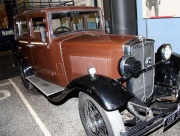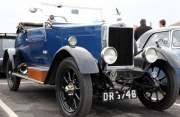Morris: Flatnose



















Note: This is a sub-section of Morris.
Morris Oxford (Flatnose) (1926–30) & Six (1929–33) - 32,282 made
Body style 4-door tourer, 4-door saloon, 4-door fabric saloon, 2-door coupé
Engine 1802 cc side-valve Straight-4; 1938 cc side-valve Straight-6 and 2062 cc
Wheelbase 114 in
The distinctive bullnose radiator was dropped in 1926 in an updated version of the car. The engines remained the same but a new range of bodies was offered including all steel saloons.
A 1,938 cc six-cylinder version, the LA series Oxford Six, was made between 1929 and 1933 and was much more successful than the 1920 version. Alongside the tourer and steel saloon, a fabric-bodied car was offered until 1932, when it and the tourer were dropped and a coupé introduced.
In 1932, the gearbox gained a fourth speed and the engine grew to 2,062 cc with the Q-series unit.
Morris Cowley (Flatnose) (1926–1931) - 201,692 made
Body style 2 and 4 seat tourer, coupé, 4-door saloon, folding head saloon (1930).
Engine 1548 cc side-valve Straight-4
Wheelbase 102 inches, Length 150 inches, Width 58.5 inches
The Bullnose radiator was replaced by a flat version in 1926 in a new version of the car with all steel bodies becoming available. The engines remained the same, but the Cowley unlike the Oxford, retained braking on the rear wheels only as standard, although a front brake system was available at extra cost (featured car has this fitted). The chassis was new and the suspension was updated with semi elliptic leaf springs all round plus Smiths friction type scissor shock absorbers. The brakes are rod and spring operated with cams inside the drums to actuate. Interesting to note that the rear brake drums include two sets of shoes, one of which is connected directly to the handbrake.
The chassis was further modified in 1931 to bring it in line with the Morris Major. Wire wheels became an option instead of the solid spoked artillery ones previously fitted.
Morris Cowley (1932-25) Cowley or 12/4. 39,074 made.
Body style 2 seat tourer, coupé, 4-door saloon.
Engine 1,548 or 1,802 cc side-valve Straight-4
Wheelbase 105 inches; Length 155 inches; Width 60.5 inches
The 1932 Cowley had a new chassis and Lockheed hydraulic brakes. the engine was the same Continental based unit but a larger 1,802 cc version was available as a no cost option until 1933 on the home market. There were no more four seat tourers.
A new engine, still of the same 1,548 cc was introduced in 1933 along with a shorter chassis and only a saloon body available.
From 1935 the car was called the Morris Twelve-Four.

